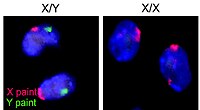
Photo from wikipedia
Clownfishes are an excellent model system for investigating the genetic mechanism governing hermaphroditism and socially-controlled sex change in their natural environment because they are broadly distributed and strongly site-attached. Genomic… Click to show full abstract
Clownfishes are an excellent model system for investigating the genetic mechanism governing hermaphroditism and socially-controlled sex change in their natural environment because they are broadly distributed and strongly site-attached. Genomic tools, such as genetic linkage maps, allow fine-mapping of loci involved in molecular pathways underlying these reproductive processes. In this study, a high-density genetic map of Amphiprion bicinctus was constructed with 3146 RAD markers in a full-sib family organized in 24 robust linkage groups which correspond to the haploid chromosome number of the species. The length of the map was 4294.71 cM, with an average marker interval of 1.38 cM. The clownfish linkage map showed various levels of conserved synteny and collinearity with the genomes of Asian and European seabass, Nile tilapia and stickleback. The map provided a platform to investigate the genomic position of genes with differential expression during sex change in A. bicinctus. This study aims to bridge the gap of genome-scale information for this iconic group of species to facilitate the study of the main gene regulatory networks governing social sex change and gonadal restructuring in protandrous hermaphrodites.
Journal Title: Scientific Reports
Year Published: 2018
Link to full text (if available)
Share on Social Media: Sign Up to like & get
recommendations!